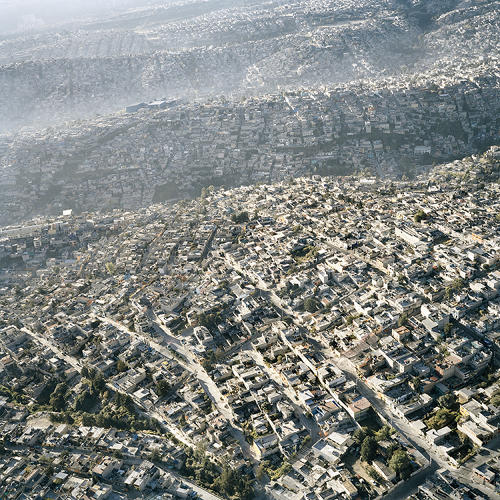ORIGINAL: FastCo Exist
Physics can help us model everything from cell growth to the movement of planets. Apparently, it also understands how cities live and die. The laws of physics can predict the movement of dust particles or the growth of cells. Can there be a universal law that predicts the growth of cities?
It seems impossible. When people decide to move from or to a city, it’s usually of their own free will. The rise and fall of urban populations is dependent on thousands, if not millions, of individual decisions that people make about their lives every day, and these are often related to longer-term policy decisions, economic climates, and political trends. Cities have memory.
However, physicists in Spain have created what they believe to be a model for predicting how any given cities’ population will fall and rise, based on knowledge of the city’s past and current state, as well as data about population trends in neighboring cities.
“We found that cities have memory, in the demographic sense. We can measure the characteristic time of this memory. For the Spanish city, it’s 15 years,” quantum physicist Alberto Hernando de Castro, the lead author of a new study published in the Journal of the Royal Society Interface, tells Co.Exist.
While studying a historical dataset of Spanish cities dating back 100 years, he and his co-authors discovered two underlying rules.
The case of Barcelona was very typical of the trends Hernando, a researcher at Ecole Polytechnique Federale de Lausanne, found over the last 50 years as Spanish residents moved from small villages to big cities. He could model how cities close to Barcelona, even if they started small, grew in tandem with the urban hub and developed a full “multi-core metropolitan area.” “It can sound obvious to some people, but what we have learned is how to measure and quantify these phenomena. If we can analyze it quantitatively, it means that in a near future we can accurately simulate it, and predict the complex outcome that a migration of this kind can generate in the future,” he says.
The work began when Hernando, finishing his PhD in Barcelona at the time, started investigating intriguing patterns he noticed in Spain’s 2008 electoral results. He saw that when correlated to the population of a city, he could predict the electoral results for each party based on the same physical models he usually in his own work. Like dust floating in the air, each individual decision was like a randomly moving particle, but when millions of decisions were viewed as one, he got something like Newton’s laws of motion: a predictable equation about how a system should behave--about where the dust would settle.
 |
| [Image: ChameleonsEye via Shutterstock] |
It seems impossible. When people decide to move from or to a city, it’s usually of their own free will. The rise and fall of urban populations is dependent on thousands, if not millions, of individual decisions that people make about their lives every day, and these are often related to longer-term policy decisions, economic climates, and political trends. Cities have memory.
However, physicists in Spain have created what they believe to be a model for predicting how any given cities’ population will fall and rise, based on knowledge of the city’s past and current state, as well as data about population trends in neighboring cities.
“We found that cities have memory, in the demographic sense. We can measure the characteristic time of this memory. For the Spanish city, it’s 15 years,” quantum physicist Alberto Hernando de Castro, the lead author of a new study published in the Journal of the Royal Society Interface, tells Co.Exist.
While studying a historical dataset of Spanish cities dating back 100 years, he and his co-authors discovered two underlying rules.
- The first “law” was that cities have inertia: A city’s future growth depended heavily on its past---particularly the last 15 years of history. Looking back 30 years wouldn’t help improve a prediction, and 10 years was probably not enough.
- Secondly, they also found that cities can become “entangled” with each other: Nearby urban bodies, particularly those within 50 miles, played a big role in predicting a given city’s fate.
The case of Barcelona was very typical of the trends Hernando, a researcher at Ecole Polytechnique Federale de Lausanne, found over the last 50 years as Spanish residents moved from small villages to big cities. He could model how cities close to Barcelona, even if they started small, grew in tandem with the urban hub and developed a full “multi-core metropolitan area.” “It can sound obvious to some people, but what we have learned is how to measure and quantify these phenomena. If we can analyze it quantitatively, it means that in a near future we can accurately simulate it, and predict the complex outcome that a migration of this kind can generate in the future,” he says.
The work began when Hernando, finishing his PhD in Barcelona at the time, started investigating intriguing patterns he noticed in Spain’s 2008 electoral results. He saw that when correlated to the population of a city, he could predict the electoral results for each party based on the same physical models he usually in his own work. Like dust floating in the air, each individual decision was like a randomly moving particle, but when millions of decisions were viewed as one, he got something like Newton’s laws of motion: a predictable equation about how a system should behave--about where the dust would settle.
 |
| See The Stunning Sprawl Of Mexico City's 20 Million People, From Above |
Hernando then decided to investigate whether he could describe the physics of urban migration more exactly, and found the perfect dataset to do it. Since 1900, the Spanish National Statistics Institute had been collecting data about the population of 8,100 municipalities in Spain, including a total of 45 million people. It is one of the longest-running and most comprehensive collections of urban populations in the world. For the last three decades, Spain had collected population every year, rather than every 10 years, as in the United States.
Eventually, Hernando plans to add information about cities, such as the health of companies in a region, that predict economic trends in addition to population trends. He also needs to expand the model to other cities--the 15 years of “memory” might be 25 years in the U.S., for example. But he believes his basic model is universal: “The physics laws are the same everywhere,” he says. “The physics here in Barcelona should be the same as the physics in New York City.”
Right now, he’s tracking the “paradigmatic case” of Detroit’s decline, which is tied to both global and local forces in the last few decades. He is looking for other cities that show very similar population signatures in how they interact with the larger system of demographic trends: “Those cities that we find highly correlated with Detroit, will they have the same fate? We don’t know at this moment, but we hope that the development of virtual simulations will help us to understand how a system of cities behave in advance.”
Comments
Post a Comment